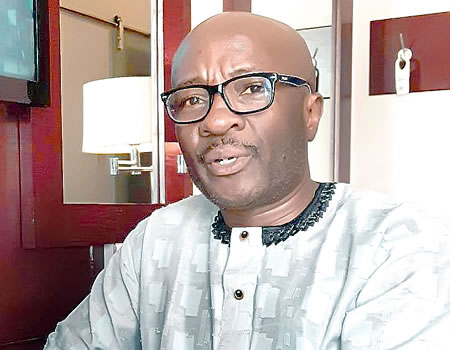Dr Kayode Sanni, the Rice Project Manager of the African Agriculture Technology Foundation (AATF) in this interview, highlights the benefits of the transgenic rice, Nitrogen Efficient Water Efficient Salt Tolerant (NEWEST) rice which is currently undergoing regulatory trials in Nigeria and other countries. COLLINS NNABUIFE brings excerpt.
Where are we on the NEWEST rice project?
Currently, we have conducted over 15 confined field trials in three African countries and one country in Latin America, Colombia, by International Centre for Tropical Agriculture (CIAT), and we are working in three countries in Africa. So, our target in the project is to get those materials released in the three countries where we are carrying out the trials.
We actually did the first trial in Badeggi, Niger State in 2016, since then, we have been carrying out different trials. Currently, we are at a stage we call regulatory trial and the purpose of this trial is to develop a dossier which will be submitted to the National Biosafety Management Agency (NBMA) for eventual environmental release, and it is after the environmental release that we will present the material to National Varietal Release Committee to be able to release it as a variety. When it is released as a variety that is when it gets to the hands of the farmers for use, and the first step in that is to get it after it is released to the hand of the local seed companies that are going to produce the seed and make it available for farmers’ use.
So, that is where we are currently in the project. The regulatory trial is going on in four different locations, the first location is Badeggi in Niger State, the second trial is going on in Mokwa, Niger State and the third trial is going on in Kumasi, Ghana and the fourth trial is going on in Uganda.
We are going to get result on the environmental safety, we have conducted result on the early food safety, the result has shown that the product is safe for human consumption, it has no allergenicity. Samples are being collected for compositional analysis, and the purpose of the compositional analysis is to show that there is no difference between the transformed product and the original product that was not transformed apart from the yield that we said we are going to get under low nitrogen condition.
And one big advantage of the technology is that currently the fertiliser use is about 120kg of nitrogen per hectare and we all know the cost of fertiliser. We all know that it is not easily accessible to farmers. So, what this technology is doing is that it is maximizing the advantage of Nitrogen in the soil, for instance, when you apply your fertiliser to a soil, 70 per cent of that nutrient is depleted, the plant does not use it, it is wasted, but what we have done in the nitrogen Use Efficiency is to be able to reverse it and make the plant to be able to use 70 per cent of the nitrogen and just about 30 per cent is wasted.
What that is translating is that even at 30 to 60kg nitrogen per hectare, the rice plant can still be able to give the farmer the yield, an additional fertiliser can make the yield to go up, but the good thing is that even at that low level of nitrogen, the farmer can still get the normal yield he is supposed to get. And what it means to the income of the farmer is that it reduces the cost of production by the farmer, and that will make the product of the farmer to be competitive with the imported in terms of cost because when the cost of production per hectare goes down it translates to a cost in terms of price which the farmer is going to sell the rice. So, that can help bring down the cost of the rice in the market, that’s one very good advantage.
The other is that it makes the farmer to be able to produce more because of the farmers do not have enough money or have access to large quantity of fertiliser, the little he has access to, he can still use it to have a production which will still give him the kind of yield which he would still get from other varieties using high dosage of fertiliser.
The second important thing is about the environment, because when you reduce the amount of fertiliser you use, you are reducing the amount of fertiliser residue on the soil which has a negative impact on the environment. So, you are reducing the toxicity of nitrogen in the soil. It also help reduce the amount of nitrogen transmitted in the atmosphere because you have reduced the amount of nitrogen you are using, the amount of nitrogen that is transmitted to the atmosphere is cut down, so invariably at some level, it helps you to protect the environment and reduce the amount of fertiliser residue on the soil, increase the yield, reduce environmental pollution, and also, it is a kind of mitigation against climate change because when there is depletion of the soil, maybe due to some hazardous effect, runaway of the soil surface which reduces the amount of nutrients on the surface of the soil, that is the impact of climate change, and the technology does not remove climate change, but it helps the plant to survive under it, so that is exactly what it does.
Don’t you think the experiment is taking too long?
When you are doing transgenic research, it has different stages you have to go through, and we have gone through those necessary stages which helped us to identify what is called the lead event, that is the best event needed to be able to move to the next stage, it takes time for that to happen, we started work on this in Nigeria in 2016 and we are now at the regulatory stage, if it were just a conventional product, we should be talking of getting it released, but we have to get the environmental release first through the NBMA and after that we can talk about varietal release.
So, it is part of the procedure of the biosafety regulation that we are following, you have to respect the time frame for it, so it is not our making, it is what the regulations say.
So, how will this variety contribute to Nigeria’s rice sustainability quest?
We don’t talk about sustainability without talking of availability of seed. You don’t talk of sustainability without talking of the economic value, you don’t talk of sustainability without talking of how to mitigate climate change.
So, the sustainability of the product comes from the fact that it is a Public Private Partnership. It is not just government driven, it is driven by government and supported by the private sector, and for the seed system to be sustainable, there must be the business incentive there for the private system, and when the private sector produces the seed and they have a market need for it, you are sure of the continuity because they are interested in business.
The second part of it is that, because one of the biggest challenges of farmers is fertiliser and because you are going to reduce the amount of fertiliser you need, it enhances sustainability. It shows that even if the fertiliser availability is not much, the farmer can still produce.
The other part is the yield increase using little fertiliser, for instance, in the past trial we have been able to record about 40 per cent increase in yield, which shows that the farmer is going to use lesser cost of production to produce the crop, and still get an increase of about 40 per cent yield. So, that is a reduction in cost of production which can invariably translate into the reduction in price of locally produced rice and as a result, that will make rice produced to be competitive, and when it is competitive with the imported, people will be able to buy more rice, farmers can produce more, and the more farmers can produce, the more the capacity of the farmer to produce is increased.
Those are the areas of sustainability, because when you are talking of sustainability, the business part of it is what makes it sustainable. If the farmer is not seeing any added profit, or their livelihood is not increasing as a result of product, there is no way for sustainability. The more people buy, the more the chance for sustainability.
When do you intend to go on a multi-locational trial?
The technology is a transgenic technology, and because it is transgenic, you cannot go into multi-locational trials until you have environmental release. Now when we finish the regulatory trial towards the end of this year, and we submit the dossier to NBMA and we get the environmental release, then we can produce all across the country, but for now, since we have not submitted the regulatory trial result and we have not gotten the environmental release, we can only produce in confined environments, and confined environment cannot be established in everywhere. It is cost intensive and as a result of that, that is why we are confined in two locations.
The rice being a GM crop, how do you allay the fears from the public in GMOs?
Part of the move in reducing the fear in the mind of people in the country, is through education, through awareness and let people understand the rudiments of the technology, to let them understand the basics and understand the politics and be able to differentiate the reality from the economic politics that is happening.
The fear about GMOs without any reservations has nothing to do with science. It is economy and political fear that is in the heart of people, it has nothing to do with science, so we are going to do a lot of awareness which we already started with the cowpea that has been released, we will build on that, leverage on that to remove that fear.
I want to let you know that the fear is gradually reducing by the awareness that is being created through the release of cowpea and as a result of that, gradually, there will be an improvement in the perception of people but there is one thing we really need to understand and get clearly: a hungry man is an angry man. This technology has been used globally to improve health, it has been used globally to tame hunger and we as Africans have to understand one thing, the biggest issue we have is food security and we should not copy any country.
We should develop our own science and our own information based on what is on ground which the NBMA has the capability to develop, to prove that the science is responsibly used; that’s very important.
By the time all the awareness comes out, people will understand the basis of it. The scientists have a lot of things to do in that, the communicators have a lot of things to do in that by giving the right information that is needed to be given to the populace. That is extremely important.
By passing through different levels, not top-down, it has to happen simultaneously on the grassroots level. It has to happen at the top, and at the top, I believe that a lot of awareness has been created that’s why we have the NBMA in place, that’s why we have National Biosafety regulations passed into law, that’s why the agency was formed, so that’s to tell you that at the top level, the awareness is very high, but at the farmers level, the grassroots level, there is a need to improve on the awareness.






